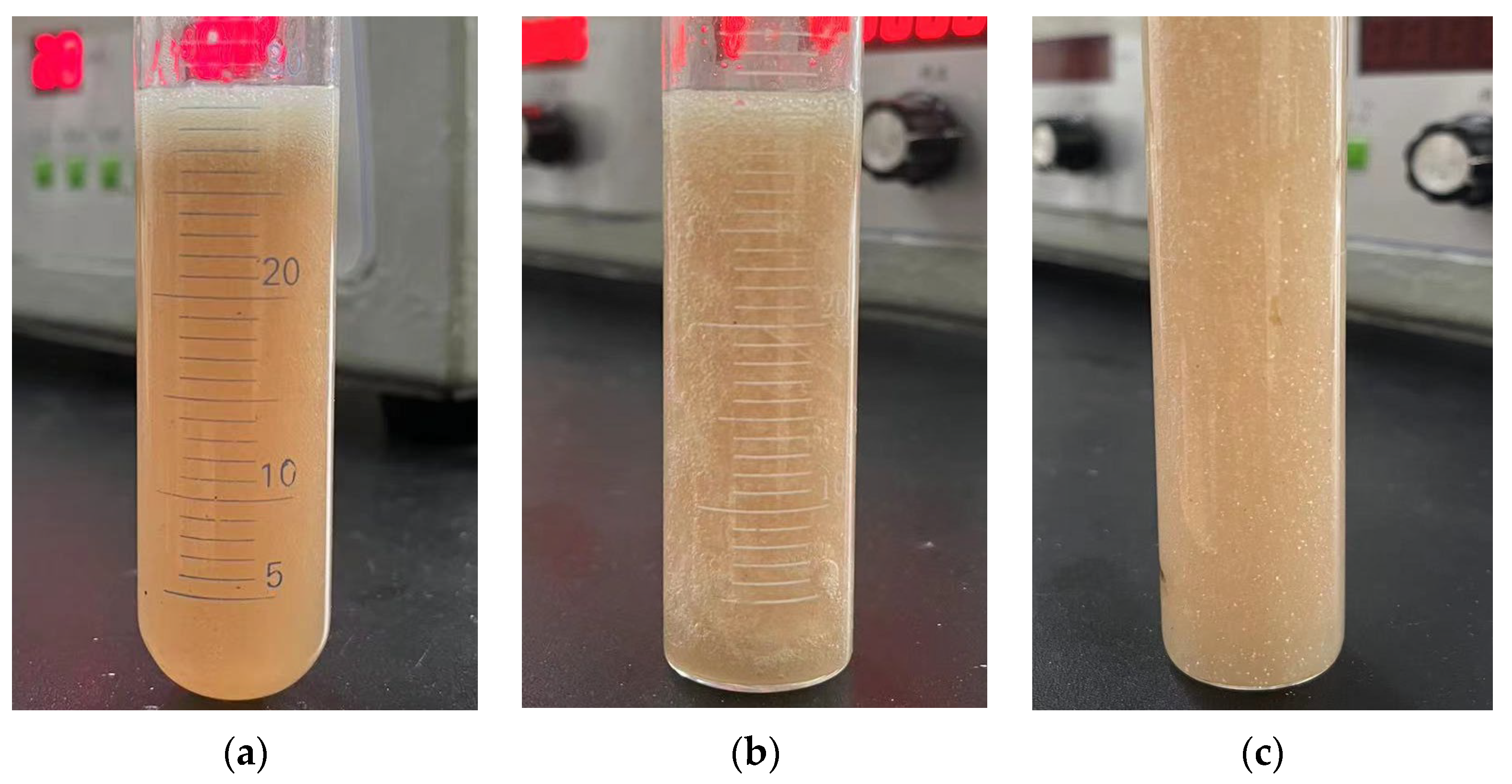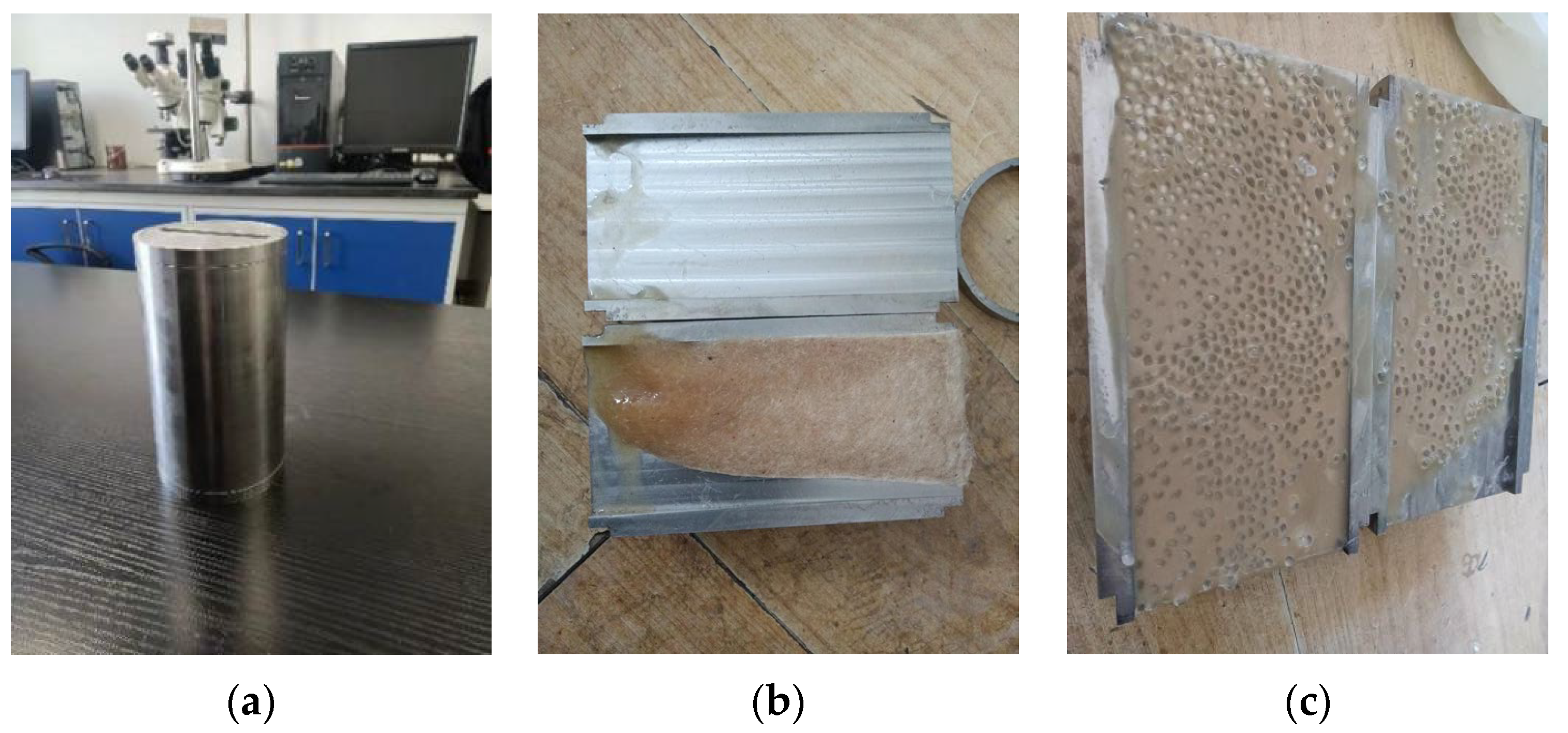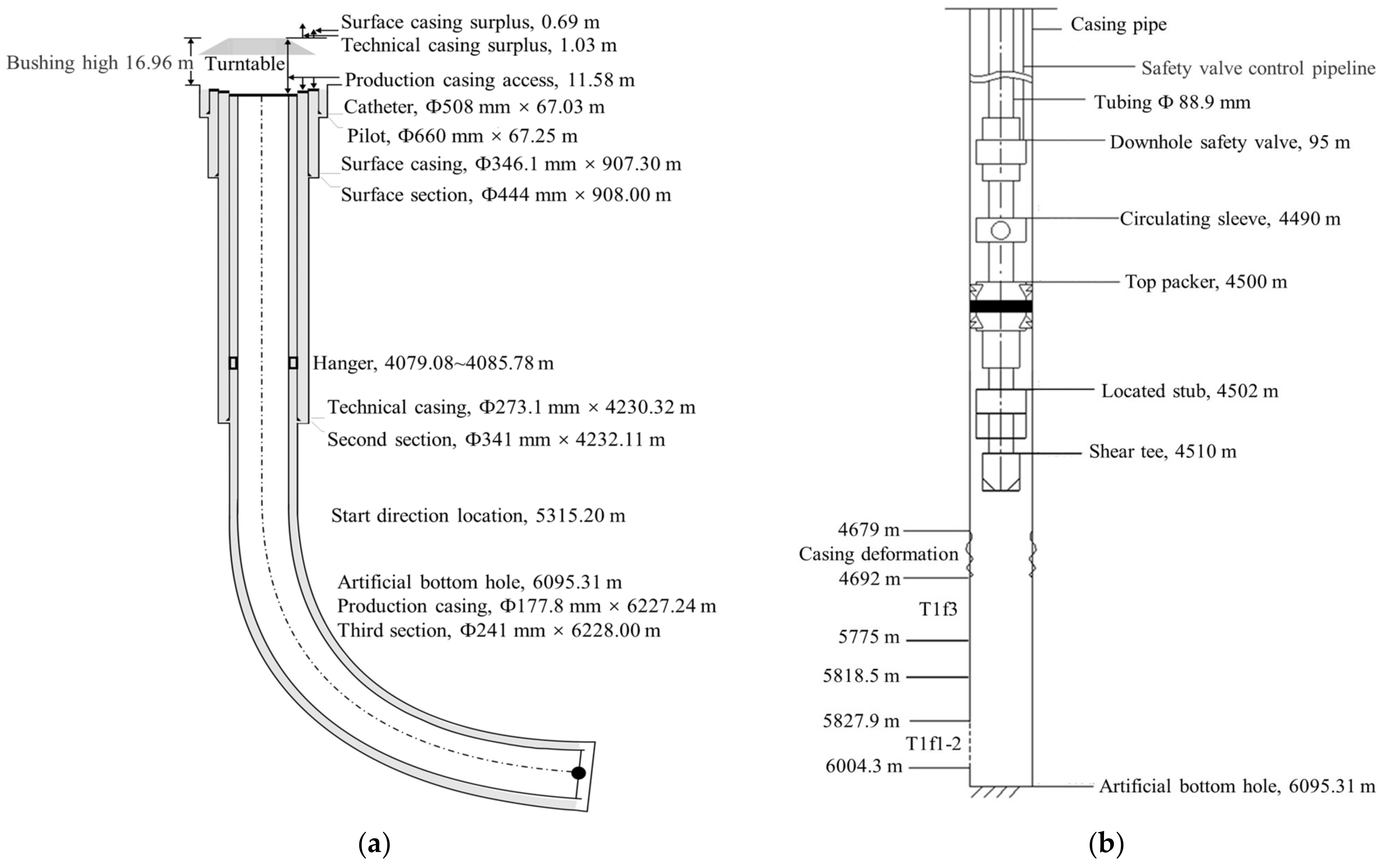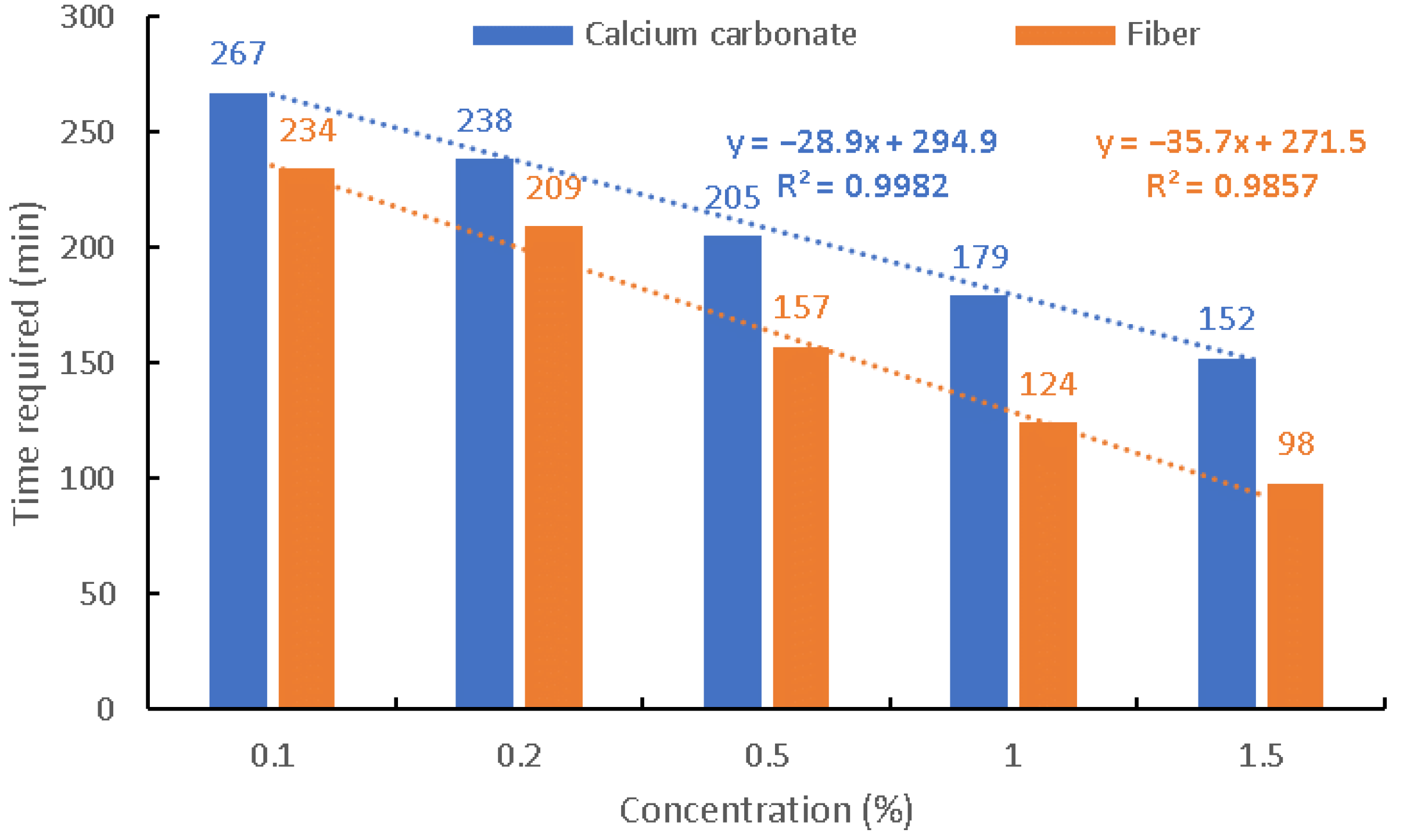Plugging Efficiency in Fractured Carbonate Gas Reservoirs Using Fuzzy-Ball Fluids Combined with Solid Plugging Agents
Abstract
:1. Introduction
2. Study Objectives
3. Laboratory Experiment
3.1. Experimental Materials
3.2. Experimental Setup
- (1)
- Measurement of the volume of sealing fluid used to reach the target pressure. With a set injection rate of 5 mL/min and mass concentrations of 0.1%, 0.2%, 0.5%, 1.0%, and 1.5% of calcium carbonate particles in the flocculated fluid, the cumulative injection volumes recorded at the fracture inlet when the driving pressure reached 20 MPa were 1832 mL, 1547 mL, 1324 mL, 1085 mL, and 975 mL, respectively. Similarly, with the same flow rate and mass concentrations of 0.1%, 0.2%, 0.5%, 1.0%, and 1.5% of the fiber in flocculated fluid, the cumulative injection volumes were 424 mL, 389 mL, 342 mL, 290 mL, and 218 mL, respectively. Notably, the choice of 20 MPa was determined based on the reservoir conditions. The vertical depth of the well is around 3500 m, i.e., the fluid pressure at the bottom of the well is about 35 MPa. With production, the formation pressure decays to about 15 MPa. Therefore, the difference between the two is 20 MPa, i.e., the pressure-bearing capacity of the plugging zone should be 20 MPa.
- (2)
- Measurement of the time taken to reach the target pressure. With an injection rate of 5 mL/min and mass concentrations of 0.1%, 0.2%, 0.5%, 1.0%, and 1.5% of calcium carbonate particles in the Fuzzy-ball fluid, the times recorded to reach a driving pressure of 20 MPa at the fracture inlet were 267 min, 238 min, 205 min, 179 min, and 152 min, respectively. Similarly, with the same flow rate and mass concentrations of 0.1%, 0.2%, 0.5%, 1.0%, and 1.5% of the fiber in the Fuzzy-ball fluid, the times recorded were 234 min, 209 min, 157 min, 124 min, and 98 min, respectively.
4. Field Application
4.1. Field Application in Well S-3X
4.2. Field Application in Well P2-Y
5. Result Analysis and Discussion
5.1. Fluid Consumption to Reach the Target Pressure
5.2. Time Required to Reach the Target Pressure
5.3. Plugging Mechanism of Fuzzy-Ball Fluid Containing Solid Plugging Agents
6. Conclusions
- The plugging efficiency of the new fluid increases as the concentration of calcium carbonate or fiber increases, and a more significant enhancement of plugging efficiency was achieved by fibers. Additionally, both the fluid consumed and the time required to reach the pre-determined bearing pressure decreased approximately linearly with increasing calcium carbonate or fiber concentration.
- The combination of Fuzzy-ball fluids with solid plugging agents could address the loss encountered during workover operation in fractured carbonate gas reservoirs and greatly improve plugging efficiency. Field trials indicate the use of Fuzzy-ball fluids with calcium carbonate or fibers reduced the fluid consumed by 33~74% and decreased the pressurization time by 33~69%. The surface pumping pressure reaches 5 and 7.9 MPa, ensuring no loss even after fluid circulation.
- The integration of solid plugging agents with Fuzzy-ball fluid could improve the plugging efficiency, reduce the consumption of Fuzzy-ball fluid, and address the associated challenges of slow pressurization and high consumption. Therefore, Fuzzy-ball fluid combined with solid plugging agents provides an optional technology for the plugging of fractured carbonate reservoirs.
7. Future Work
- The quantitative relationships between pressurization speed, fluid consumption, and fluid performance have not yet been determined, and no consistent trends have been established, which leads to a certain blindness in field application. Consequently, more tests should be conducted to find this quantitative relationship.
- Only two solid-phase plugging agents, calcium carbonate and fiber, were investigated in this study, and the feasibility of integrating with other materials, such as resins and cement, with Fuzzy-ball fluids is not yet known. This is another research direction.
- To understand the mechanisms of Fuzzy-ball fluids containing various solid-phase plugging materials, the corresponding mechanical modeling and numerical simulations need to be carried out in the following work.
Author Contributions
Funding
Data Availability Statement
Acknowledgments
Conflicts of Interest
Appendix A. Operational Procedures for Indoor Plugging Experiments
- (a)
- The experiment setup consists of the air pump, constant speed and pressure pump, pressure vessel, pipeline, core gripper, hand pump, and other combinations.
- (b)
- The components are assembled and spliced together to carry out the plugging experiment test.
- (c)
- Connect the air pump with the constant speed and constant pressure pump to provide driving capacity for it. The selection of constant speed and constant pressure pumps is mainly based on the displacement, which corresponds to a selection of parameters, mainly flow rate and pump pressure.
- (d)
- Connect the discharge end of the pump to the lower part of the pressure vessel. The pressure vessel is filled with the fluid and driven into the gripper with power provided by the pump. Select the pressure vessel according to the permeability of the core. In general, a permeability of 10 mD and below indicates of the selection of a 1 L pressure vessel; a permeability of 10 mD and above would validate the selection of a 2 L pressure vessel; if containing artificial cracks, the selection of a 3 L pressure vessel is appropriate.
- (e)
- Place the core in a core gripper of an appropriate size. If the core is short, it is necessary to place pads at both ends of the core gripper corresponding to the gripper to prevent damage to the core or gripper due to uneven forces.
- (f)
- After the core is placed, tighten the plugs at both ends. Apply surrounding pressure using a hand pump (keep the surrounding pressure always 1.5~2 MPa greater than the driving force). A line is drawn from the outlet end of the gripper and a gauge is placed to record the amount of fluid flowing out.
- (g)
- Connect the injector end of the gripper to the upper part of the pressure vessel. A pressure gauge is mounted on the injector end of the gripper to record the driving pressure during the injection process.
- (h)
- After completing the connection of the ministries, the pressure vessel will be added to the water for pre-equipment testing. The outlet end will be closed, drive the water to test the sealing of the equipment. The driving pressure will rise linearly. When the pressure reaches a certain level (about 20 MPa), stop driving and observe the connections and seals to see whether there is water leakage.
- (i)
- After eliminating leaks, depressurize the equipment. The connection between the pump and the pressure vessel will be slowly loosening the pipeline interface in the liquid outflow to stop screwing. Wait for the pressure to drop and then open the outlet end to complete the release of the internal pressure so that the equipment sealing test is completed.
- (j)
- The specification of the heating jacket should correspond with the core gripper through the temperature controller for heating (corresponding to the experiments to simulate the depth requirements of the stratum and set the temperature).
- (k)
- Fill the plugging fluid into the pressure vessel; subsequently, sealed connections are made. Pump at a constant flow rate.
- (l)
- During the driving process, continuously monitor the core outlet flow and inlet pressure changes at intervals of 1–5 min. When the continuous injection time reaches 2 h or the driving pressure exceeds 20 MPa, stop the injection.
- (m)
- The above is all the experimental procedure of the indoor plugging test.
References
- Xu, Z.-X.; Li, S.-Y.; Li, B.-F.; Chen, D.-Q.; Liu, Z.-Y.; Li, Z.-M. A review of development methods and EOR technologies for carbonate reservoirs. Pet. Sci. 2020, 17, 990–1013. [Google Scholar] [CrossRef]
- Zhang, J.; Li, Z.; Wang, D.; Xu, L.; Li, Z.; Niu, J.; Chen, L.; Sun, Y.; Li, Q.; Yang, Z.; et al. Shale gas accumulation patterns in China. Nat. Gas Ind. B 2023, 10, 14–31. [Google Scholar] [CrossRef]
- Huang, Y.; Li, Y.; Liu, F.; Chang, C.; Xie, W. Key technologies and progress of enhanced gas recovery in water-bearing carbonate gas reservoirs. Nat. Gas Ind. B 2022, 9, 336–346. [Google Scholar] [CrossRef]
- Mu, L.; Chen, Y.; Xu, A.; Wang, R. Technological progress and development directions of PetroChina overseas oil and gas field production. Pet. Explor. Dev. 2020, 47, 124–133. [Google Scholar] [CrossRef]
- Yang, Y.; He, X.; Sun, D.; Zhang, H.; Zhong, Y.; She, J. Pseudointerpenetrating network nanocomposite hydrogel for temporary plugging in fractured reservoirs. Colloids Surf. A Physicochem. Eng. Asp. 2023, 656, 130369. [Google Scholar] [CrossRef]
- Sahu, C.; Kumar, R.; Sangwai, J.S. A Comprehensive Review on Well Completion Operations and Artificial Lift Techniques for Methane Gas Production from Natural Gas Hydrate Reservoirs. Energy Fuels 2021, 35, 11740–11760. [Google Scholar] [CrossRef]
- Khalifeh, M.; Saasen, A. Introduction to Permanent Plug and Abandonment of Wells; Ocean Engineering & Oceanography; Springer International Publishing: Cham, Switzerland, 2020; Volume 12. [Google Scholar] [CrossRef]
- Universal Well Control; Elsevier: Amsterdam, The Netherlands, 2022. [CrossRef]
- Tamim, N.; Laboureur, D.M.; Hasan, A.R.; Mannan, M.S. Developing leading indicators-based decision support algorithms and probabilistic models using Bayesian network to predict kicks while drilling. Process Saf. Environ. Prot. 2019, 121, 239–246. [Google Scholar] [CrossRef]
- Guan, Z.; Chen, T.; Liao, H. Drilling Fluids. In Theory and Technology of Drilling Engineering; Springer: Singapore, 2021; pp. 173–204. [Google Scholar] [CrossRef]
- Su, X.; Lian, Z.; Fang, J.; Xiong, H.; Wu, R.; Yuan, Y. Lost circulation material for abnormally high temperature and pressure fractured-vuggy carbonate reservoirs in Tazhong block, Tarim Basin, NW China. Pet. Explor. Dev. 2019, 46, 173–180. [Google Scholar] [CrossRef]
- Bao, D.; Qiu, Z.; Ye, L.; Zhong, H.; Zhao, X.; Qiu, W.; Wang, B.; Guo, B. Preparation and characteristic experiments of intelligent lost circulation materials based on thermally shape memory polymer. Acta Pet. Sin. 2020, 41, 106–115. [Google Scholar]
- Zhang, Y.; Jin, Z. A study on reservoir protection technology in well workover operations. China Pet. Chem. Stand. Qual. 2013, 33, 179. [Google Scholar]
- Zhou, F.; Yi, X.; Yang, X.; Liu, X.; Wang, D. Dynamic filtration Experiment of fiber temporary plugging artificial fracture. Drill. Prod. Technol. 2014, 37, 83–86. [Google Scholar]
- Li, H.; Liu, H.; He, Z.; Li, Z.; Zhang, S.; Li, Q. Use gel to control severe mud losses in carbonate reservoir formations in Tahe oilfield. Drill. Fluid Complet. Fluid 2019, 36, 25–28. [Google Scholar]
- Su, J.; Wang, L.; Liu, X.; Xiong, K. Surface crack leakage gel with drilling plugging technology and application. Drill. Fluid Complet. Fluid 2018, 41, 23–25. [Google Scholar]
- Zhao, F.; Zhang, Z.; Chen, J.; Jiao, S.; Wang, Y.; Zhao, D.; Zhao, Q. Mud Loss Control Technology of Big Caves and Fractures for Well Ba-91. Drill. Fluid Complet. Fluid 2010, 27, 54–55. [Google Scholar]
- Bai, Y.; Liu, C.; Sun, J.; Lv, K. Use of a Polymer Gel for Killing a High-Temperature and High-Pressure Gas Well. SPE J. 2022, 27, 3297–3313. [Google Scholar] [CrossRef]
- Ying, X.; Yuan, X.; Yadong, Z.; Ziyi, F. Study of Gel Plug for Temporary Blocking and Well-Killing Technology in Low-Pressure, Leakage-Prone Gas Well. SPE Prod. Oper. 2021, 36, 234–244. [Google Scholar] [CrossRef]
- Wu, J.; Fan, Y.; Wu, F.; Li, C. Combining large-sized model flow experiment and NMR measurement to investigate drilling induced formation damage in sandstone reservoir. J. Pet. Sci. Eng. 2019, 176, 85–96. [Google Scholar] [CrossRef]
- Almubarak, M.; Almubarak, T.; Ng, J.H.; Hernandez, J.; Nasr-El-Din, H. Recent Advances in Waterless Fracturing Fluids: A Review. In Proceedings of the Abu Dhabi International Petroleum Exhibition and Conference, Abu Dhabi, United Arab Emirates, 9–12 November 2020; SPE: Abu Dhabi, United Arab Emirates, 2020; p. D012S116R099. [Google Scholar] [CrossRef]
- Tackie-Otoo, B.N.; Mohammed, M.A.A.; Zalghani, H.A.B.M.; Hassan, A.M.; Murungi, P.I.; Tabaaza, G.A. Interfacial Properties, Wettability Alteration and Emulsification Properties of an Organic Alkali–Surface Active Ionic Liquid System: Implications for Enhanced Oil Recovery. Molecules 2022, 27, 2265. [Google Scholar] [CrossRef]
- Brookey, T. ‘Micro-Bubbles’: New Aphron Drill-In Fluid Technique Reduces Formation Damage in Horizontal Wells. In All Days; SPE: Lafayette, LA, USA, 1998; p. SPE-39589-MS. [Google Scholar] [CrossRef]
- Zheng, L.; Su, G.; Li, Z.; Peng, R.; Wang, L.; Wei, P.; Han, S. The wellbore instability control mechanism of fuzzy ball drilling fluids for coal bed methane wells via bonding formation. J. Nat. Gas Sci. Eng. 2018, 56, 107–120. [Google Scholar] [CrossRef]
- Zheng, L.; Kong, L.; Cao, Y.; Wang, H.; Han, Z.; He, X. The mechanism for fuzzy-ball working fluids for controlling & killing lost circulation. Chin. Sci. Bull. 2010, 55, 4074–4082. [Google Scholar] [CrossRef]
- Wei, P.; Zheng, L.; Yang, M.; Wang, C.; Chang, Q.; Zhang, W. Fuzzy-ball fluid self-selective profile control for enhanced oil recovery in heterogeneous reservoirs: The techniques and the mechanisms. Fuel 2020, 275, 117959. [Google Scholar] [CrossRef]
- Lihui, Z.; Xiuyun, L.; Guandong, S.; Wei, Z.; Xuguang, G.; Xiujuan, T. Applicability of working fluid damage assessment methods for coalbed methane reservoirs. Nat. Gas Ind. 2018, 38, 28–39. [Google Scholar]
- Guo, B.G.; Zheng, L.H.; Meng, S.Z.; Zhang, Z.H. The “U-Type” Wells History of Fuzzy Ball Drilling Fluids for CBM Drilling in China. AMR 2013, 748, 1273–1276. [Google Scholar] [CrossRef]
- He, J.; Okere, C.J.; Su, G.; Hu, P.; Zhang, L.; Xiong, W.; Li, Z. Formation damage mitigation mechanism for coalbed methane wells via refracturing with fuzzy-ball fluid as temporary blocking agents. J. Nat. Gas Sci. Eng. 2021, 90, 103956. [Google Scholar] [CrossRef]
- Tao, X.; Gan, M.; Yao, Z.; Bai, J.; Yang, M.; Su, G.; Zheng, L. Enhancing the production of tight sandstone gas well through fuzzy-ball fluid temporary plugging with diverting fractures and water cutting after refracturing in one operation. J. Pet. Sci. Eng. 2022, 217, 110883. [Google Scholar] [CrossRef]
- Yan, Z.; Okere, C.J.; Zeng, X.; Yao, Z.; Su, G.; Gan, M.; Fu, Y.; Tao, X.; Zheng, L. Preventing sour gas kicks during workover of natural gas wells from deep carbonate reservoirs with anti-hydrogen sulfide fuzzy-ball kill fluid. Energy Sci. Eng. 2022, 10, 2674–2688. [Google Scholar] [CrossRef]
- Zhang, Y.; Su, G.; Zheng, L.; Liu, D.; Guo, Z.; Wei, P. The environmental friendliness of fuzzy-ball drilling fluids during their entire life-cycles for fragile ecosystems in coalbed methane well plants. J. Hazard. Mater. 2019, 364, 396–405. [Google Scholar] [CrossRef]








| Materials | Components | Functions |
|---|---|---|
| Coating agent | A copolymer of sodium carboxymethyl cellulose, acrylamide, and 2-acrylamide-2-methyl propane sulfonic acid | Form the ball layers and control the layer density |
| Floss agent | A graft copolymer of cellulose/acrylamide/2-methyl-2-propenyl ammonium chloride | Create flocs adsorbed on the ball |
| Core agent | sodium dodecylbenzenesulfonate and lauroyl isopropanol amid | Control ball size and increase its stability period |
| Membrane agent | Polyethylene glycol and betaine compounds | Improve ball membrane density and high-pressure stability |
| High temperature stabilizer | Triethanolamine | Improve temperature resistance |
| Calcium carbonate | CaCO3 | Improve plugging efficiency |
| Plant fibers | Prepared by modifying cotton fibers |
Disclaimer/Publisher’s Note: The statements, opinions and data contained in all publications are solely those of the individual author(s) and contributor(s) and not of MDPI and/or the editor(s). MDPI and/or the editor(s) disclaim responsibility for any injury to people or property resulting from any ideas, methods, instructions or products referred to in the content. |
© 2023 by the authors. Licensee MDPI, Basel, Switzerland. This article is an open access article distributed under the terms and conditions of the Creative Commons Attribution (CC BY) license (https://creativecommons.org/licenses/by/4.0/).
Share and Cite
Zhu, F.; Zheng, L.; Zhao, Y.; Chang, Q.; Li, J.; Zhang, Q. Plugging Efficiency in Fractured Carbonate Gas Reservoirs Using Fuzzy-Ball Fluids Combined with Solid Plugging Agents. Energies 2023, 16, 6688. https://doi.org/10.3390/en16186688
Zhu F, Zheng L, Zhao Y, Chang Q, Li J, Zhang Q. Plugging Efficiency in Fractured Carbonate Gas Reservoirs Using Fuzzy-Ball Fluids Combined with Solid Plugging Agents. Energies. 2023; 16(18):6688. https://doi.org/10.3390/en16186688
Chicago/Turabian StyleZhu, Fanghui, Lihui Zheng, Yang Zhao, Qifan Chang, Jiahui Li, and Qinhao Zhang. 2023. "Plugging Efficiency in Fractured Carbonate Gas Reservoirs Using Fuzzy-Ball Fluids Combined with Solid Plugging Agents" Energies 16, no. 18: 6688. https://doi.org/10.3390/en16186688
APA StyleZhu, F., Zheng, L., Zhao, Y., Chang, Q., Li, J., & Zhang, Q. (2023). Plugging Efficiency in Fractured Carbonate Gas Reservoirs Using Fuzzy-Ball Fluids Combined with Solid Plugging Agents. Energies, 16(18), 6688. https://doi.org/10.3390/en16186688







